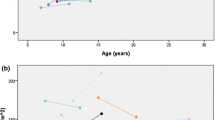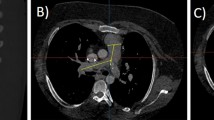Abstract
We developed models of pulmonary artery (PA) size in Fontan patients as a function of age and body surface area (BSA) using linear regression and breakpoint analyses based on data from 43 Fontan patients divided into two groups: the extracardiac conduit (ECC) group (n = 24) and the non-ECC group (n = 19). Model predictions were compared against those of a non-Fontan control group (n = 18) and published literature. We observed strong positive correlations of the mean PA diameter with BSA (r = 0.9, p < 0.05) and age (r = 0.88, p < 0.05) in the ECC group. The absolute percentage differences between our BSA and age model predictions against published literature were less than 16% and 20%, respectively. Predicted PA size for Fontan patients was consistently smaller than the control group. These models may serve as useful references for clinicians and be utilized to construct 3D anatomic models that correspond to patient body size or age.



Similar content being viewed by others
Abbreviations
- 3D:
-
Three-dimensional
- BSA:
-
Body surface area
- CFD:
-
Computational fluid dynamics
- ECC:
-
Extracardiac conduit
- MRI:
-
Magnetic resonance imaging
- PA:
-
Pulmonary arteries
References
de Zélicourt, D. A., & Kurtcuoglu, V. (2016). Patient-specific surgical planning, where do we stand? The example of the Fontan procedure. Annals of Biomedical Engineering, 44(1), 174–186. https://doi.org/10.1007/s10439-015-1381-9.
Bossers, S. S. M., Cibis, M., Gijsen, F. J., Schokking, M., Strengers, J. L. M., Verhaart, R. F., et al. (2014). Computational fluid dynamics in Fontan patients to evaluate power loss during simulated exercise. Heart (British Cardiac Society), 100(9), 696–701. https://doi.org/10.1136/heartjnl-2013-304969.
Tang, E., Wei, Z. (. A.)., Whitehead, K. K., Khiabani, R. H., Restrepo, M., Mirabella, L., et al. (2017). Effect of Fontan geometry on exercise haemodynamics and its potential implications. Heart, 103(22), 1806–1812. https://doi.org/10.1136/heartjnl-2016-310855.
Khiabani, R. H., Whitehead, K. K., Han, D., Restrepo, M., Tang, E., Bethel, J., et al. (2015). Exercise capacity in single-ventricle patients after Fontan correlates with haemodynamic energy loss in TCPC. Heart, 101(2), 139–143. https://doi.org/10.1136/heartjnl-2014-306337.
Kung, E., Baretta, A., Baker, C., Arbia, G., Biglino, G., Corsini, C., et al. (2013). Predictive modeling of the virtual hemi-Fontan operation for second stage single ventricle palliation: two patient-specific cases. Journal of Biomechanics, 46(2), 423–429. https://doi.org/10.1016/j.jbiomech.2012.10.023.
Baretta, A., Corsini, C., Yang, W., Vignon-Clementel, I. E., Marsden, A. L., Feinstein, J. A., et al. (2011). Virtual surgeries in patients with congenital heart disease: a multi-scale modelling test case. Philosophical transactions. Series A, Mathematical, physical, and engineering sciences, 369(1954), 4316–4330. https://doi.org/10.1098/rsta.2011.0130.
Marsden, A. L., Bernstein, A. J., Reddy, V. M., Shadden, S. C., Spilker, R. L., Chan, F. P., et al. (2009). Evaluation of a novel Y-shaped extracardiac Fontan baffle using computational fluid dynamics, Journal of Thoracic and Cardiovascular Surgery., 137(2), 394–403.e2. https://doi.org/10.1016/j.jtcvs.2008.06.043.
Dasi, L. P., KrishnankuttyRema, R., Kitajima, H. D., Pekkan, K., Sundareswaran, K. S., Fogel, M., et al. (2009). Fontan hemodynamics: importance of pulmonary artery diameter. Journal of Thoracic and Cardiovascular Surgery, 137(3), 560–564. https://doi.org/10.1016/j.jtcvs.2008.04.036.
Tatum, G. H., Sigfússon, G., Ettedgui, J. A., Myers, J. L., Cyran, S. E., Weber, H. S., & Webber, S. A. (2006). Pulmonary artery growth fails to match the increase in body surface area after the Fontan operation. Heart (British Cardiac Society), 92(4), 511–514. https://doi.org/10.1136/hrt.2005.070243.
Ovroutski, S., Ewert, P., Alexi-Meskishvili, V., Hölscher, K., Miera, O., Peters, B., et al. (2009). Absence of pulmonary artery growth after Fontan operation and its possible impact on late outcome. Annals of Thoracic Surgery, 87(3), 826–831. https://doi.org/10.1016/j.athoracsur.2008.10.075.
Buheitel, G., Hofbeck, M., Tenbrink, U., Leipold, G., von der Emde, J., & Singer, H. (1997). Changes in pulmonary artery size before and after total cavopulmonary connection. Heart (British Cardiac Society), 78(5), 488–492.
Restrepo, M., Mirabella, L., Tang, E., Haggerty, C. M., Khiabani, R. H., Fynn-Thompson, F., et al. (2014). Fontan pathway growth: a quantitative evaluation of lateral tunnel and extracardiac cavopulmonary connections using serial cardiac magnetic resonance. Annals of Thoracic Surgery, 97(3), 916–922. https://doi.org/10.1016/j.athoracsur.2013.11.015.
Robbers-Visser, D., Helderman, F., Strengers, J. L., van Osch-Gevers, L., Kapusta, L., Pattynama, P. M., et al. (2008). Pulmonary artery size and function after Fontan operation at a young age. Journal of magnetic resonance imaging : JMRI, 28(5), 1101–1107. https://doi.org/10.1002/jmri.21544.
Bossers, S. S. M., Cibis, M., Kapusta, L., Potters, W. V., Snoeren, M. M., Wentzel, J. J., et al. (2016). Long-term serial follow-up of pulmonary artery size and wall shear stress in Fontan patients. Pediatric Cardiology. https://doi.org/10.1007/s00246-015-1326-y.
Nakata, S., Imai, Y., Takanashi, Y., Kurosawa, H., Tezuka, K., Nakazawa, M., et al. (1984). A new method for the quantitative standardization of cross-sectional areas of the pulmonary arteries in congenital heart diseases with decreased pulmonary blood flow, The Journal of thoracic and cardiovascular surgery., 88(4), 610–619 Retrieved from http://www.ncbi.nlm.nih.gov/pubmed/6482493. Accessed 10 Sept 2019.
R Core Team. (2018). R: a language and environment for statistical computing. Vienna, Austria. Retrieved from https://www.r-project.org/. Accessed 10 Sept 2019.
Muggeo, V. M. R. (2008). Segmented: an R package to fit regression models with broken-line relationships. R News, 8(1), 20–25 Retrieved from https://cran.r-project.org/doc/Rnews/. Accessed 10 Sept 2019.
Muggeo, V. M. R. (2003). Estimating regression models with unknown break-points. Statistics in Medicine, 22, 3055–3071.
Restrepo, M., Tang, E., Haggerty, C. M., Khiabani, R. H., Mirabella, L., Bethel, J., et al. (2015). Energetic implications of vessel growth and flow changes over time in Fontan patients. Annals of Thoracic Surgery, 99(1), 163–170. https://doi.org/10.1016/j.athoracsur.2014.08.046.
Kansy, A., Brzezińska-Rajszys, G., Zubrzycka, M., Mirkowicz-Małek, M., Maruszewski, P., Manowska, M., & Maruszewski, B. (2013). Pulmonary artery growth in univentricular physiology patients. Kardiologia Polska, 71(6), 581–587. https://doi.org/10.5603/KP.2013.0121.
Borowski, A., Reinhardt, H., Schickendantz, S., & Korb, H. (1998). Pulmonary artery growth after systemic-to-pulmonary shunt in children with a univentricular heart and a hypoplastic pulmonary artery bed. Implications for Fontan surgery. Japanese Heart Journal, 39(5), 671–680. https://doi.org/10.1016/j.athoracsur.2004.05.055.
Reddy, V. M., McElhinney, D. B., Moore, P., Petrossian, E., & Hanley, F. L. (1996). Pulmonary artery growth after bidirectional cavopulmonary shunt: is there a cause for concern? The Journal of Thoracic and Cardiovascular Surgery, 112(5), 1180–1190; discussion 1190-1192. https://doi.org/10.1016/S0022-5223(96)70131-9.
Knott-Craig, C. J., Julsrud, P. R., Schaff, H. V., Puga, F. J., & Danielson, G. K. (1993). Pulmonary artery size and clinical outcome after the modified Fontan operation. The Annals of Thoracic Surgery, 55(3), 646–651. https://doi.org/10.1016/0003-4975(93)90268-M.
Lehner, A., Schuh, A., Herrmann, F. E. M., Riester, M., Pallivathukal, S., Dalla-Pozza, R., et al. (2014). Influence of pulmonary artery size on early outcome after the Fontan operation. Annals of Thoracic Surgery, 97(4), 1387–1393. https://doi.org/10.1016/j.athoracsur.2013.11.068.
Adachi, I., Yagihara, T., Kagisaki, K., Hagino, I., Ishizaka, T., Kobayashi, J., et al. (2007). Preoperative small pulmonary artery did not affect the midterm results of Fontan operation. European Journal of Cardio-Thoracic Surgery, 32(1), 156–162. https://doi.org/10.1016/j.ejcts.2007.03.024.
Senzaki, H., Isoda, T., Ishizawa, A., & Hishi, T. (1994). Reconsideration of criteria for the Fontan operation. Influence of pulmonary artery size on postoperative hemodynamics of the Fontan operation. Circulation, 89(3), 1196–1202. https://doi.org/10.1161/01.CIR.89.3.1196.
Baek, J. S., Bae, E. J., Kim, G. B., Kim, W. H., Lee, J. R., Kim, Y. J., et al. (2011). Pulmonary artery size and late functional outcome after Fontan operation. Annals of Thoracic Surgery, 91(4), 1240–1246. https://doi.org/10.1016/j.athoracsur.2010.12.002.
Wagner, M., Nguyen, K.-L., Khan, S., Mirsadraee, S., Satou, G. M., Aboulhosn, J., & Finn, J. P. (2012). Contrast-enhanced MR angiography of cavopulmonary connections in adult patients with congenital heart disease. AJR. American Journal of Roentgenology, 199(5), W565–W574. https://doi.org/10.2214/AJR.11.7503.
Acknowledgements
We would like to thank the Department of Mechanical Engineering at Clemson University for their support.
Funding
This work was supported by an Award from the American Heart Association, The Children’s Heart Foundation, and the Department of Mechanical Engineering at Clemson University. J.P. Mynard is supported by a co-funded Career Development Fellowship from the National Health and Medical Research Council of Australia and a Future Leader Fellowship from the National Heart Foundation. The Heart Research group at MCRI (J.P. Mynard) is supported by the Victorian Government’s Operational Infrastructure Support Program, Big W, and RCH1000.
Author information
Authors and Affiliations
Contributions
A. Gupta contributed to the conception of this work, performed the statistical analyses and interpretation of the data, and drafted the manuscript. C. Gillett acquired data and revised the work critically for important intellectual content. P. Gerard contributed to the design of the study and performed critical revision for intellectual content. M.M.H. Cheung contributed to data acquisition and performed critical revision for intellectual content. J.P. Mynard contributed to the design of the study and performed critical revision for intellectual content. E. Kung contributed to the conception and design of the study and performed critical revision for intellectual content. All authors have approved the submitted version of the manuscript.
Corresponding author
Ethics declarations
The funding agencies/sponsors had no involvement in the study design; in the collection, analysis and interpretation of the data; in the writing of the report; and in the decision to submit the paper for publication.
Conflict of Interest
The authors declare that they have no conflict of interest.
Human Subjects/Informed Consent Statement
Informed consent was not necessary as the data did not contain any identifying information.
Institutional Review Board Approval
The Human Research Ethics Committee of the Royal Children’s Hospital Melbourne approved the retrospective use of data for this study (Ref. No: 37205A).
Animal Studies
No animal studies were carried out by the authors for this article.
Additional information
Associate Editor Ana Barac oversaw the review of this article
Publisher’s Note
Springer Nature remains neutral with regard to jurisdictional claims in published maps and institutional affiliations.
Electronic Supplementary Material
ESM 1
(DOCX 686 kb)
Rights and permissions
About this article
Cite this article
Gupta, A., Gillett, C., Gerard, P. et al. Predictive Models for Pulmonary Artery Size in Fontan Patients. J. of Cardiovasc. Trans. Res. 14, 782–789 (2021). https://doi.org/10.1007/s12265-020-09993-4
Received:
Accepted:
Published:
Issue Date:
DOI: https://doi.org/10.1007/s12265-020-09993-4




